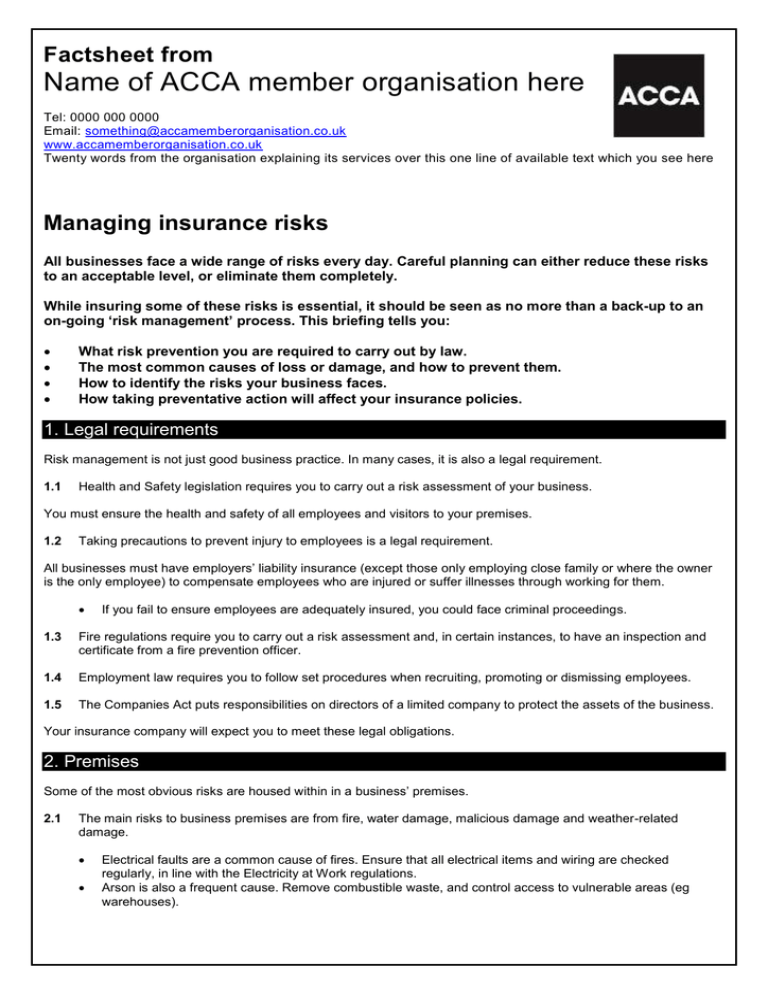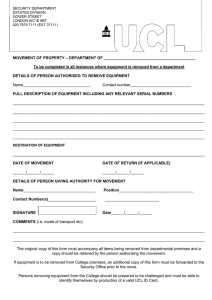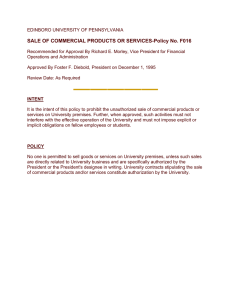
Factsheet from
Name of ACCA member organisation here
Tel: 0000 000 0000
Email: something@accamemberorganisation.co.uk
www.accamemberorganisation.co.uk
Twenty words from the organisation explaining its services over this one line of available text which you see here
Managing insurance risks
All businesses face a wide range of risks every day. Careful planning can either reduce these risks
to an acceptable level, or eliminate them completely.
While insuring some of these risks is essential, it should be seen as no more than a back-up to an
on-going ‘risk management’ process. This briefing tells you:
What risk prevention you are required to carry out by law.
The most common causes of loss or damage, and how to prevent them.
How to identify the risks your business faces.
How taking preventative action will affect your insurance policies.
1. Legal requirements
Risk management is not just good business practice. In many cases, it is also a legal requirement.
1.1
Health and Safety legislation requires you to carry out a risk assessment of your business.
You must ensure the health and safety of all employees and visitors to your premises.
1.2
Taking precautions to prevent injury to employees is a legal requirement.
All businesses must have employers’ liability insurance (except those only employing close family or where the owner
is the only employee) to compensate employees who are injured or suffer illnesses through working for them.
If you fail to ensure employees are adequately insured, you could face criminal proceedings.
1.3
Fire regulations require you to carry out a risk assessment and, in certain instances, to have an inspection and
certificate from a fire prevention officer.
1.4
Employment law requires you to follow set procedures when recruiting, promoting or dismissing employees.
1.5
The Companies Act puts responsibilities on directors of a limited company to protect the assets of the business.
Your insurance company will expect you to meet these legal obligations.
2. Premises
Some of the most obvious risks are housed within in a business’ premises.
2.1
The main risks to business premises are from fire, water damage, malicious damage and weather-related
damage.
Electrical faults are a common cause of fires. Ensure that all electrical items and wiring are checked
regularly, in line with the Electricity at Work regulations.
Arson is also a frequent cause. Remove combustible waste, and control access to vulnerable areas (eg
warehouses).
Water damage is mainly caused by burst pipes and leaks from water tanks.
Carry out regular inspections, maintenance and repairs.
Glass is a favourite target for vandals.
Glass windows and doors can be made of toughened glass, or protected with grilles or bars, but check you do
not require planning permission to install them.
Flooding and structural damage to your premises can be caused by severe weather.
Make sure gutters and drains are cleared and that roofs are kept in good repair. Find out if your premises are
located in a flood risk area and sign up for local flood watch warnings. Find tips on minimising flood damage and
how to draw up a flood action plan on the Environment Agency website (www.environment-agency.gov.uk).
2.2
Improve security systems and procedures.
Burglar alarms are a good visible deterrent.
For reliability, they should comply with British Standard 4737-3.0:1988.
The company installing and maintaining them should be approved by the National Security Inspectorate (NSI,
01628 637 512; www.nsi.org.uk). Insurers will also consider alarms approved by the Security Systems and
Alarms Inspection Board (SSAIB, 0191 296 3242; www.ssaib.co.uk). Look for alarms using Redcare signalling.
2.3
Ensure burglar alarm codes and keys are only available to authorised persons.
Ensure all telephone line faults are dealt with immediately. The fault could have been caused by a burglar (to
disconnect your alarm from the security call centre).
Make sure all visitors identify themselves and state who they are visiting.
Appoint a person to check the premises are secure at the end of each working day.
A professional approach to managing your premises will prevent many problems.
Draw up a list of items which need regular inspection and maintenance.
For example, roofs, pipes, tanks and stopcocks are all potential sources of leaks.
If your premises are liable to flood, keep your stock above ground level.
Ask your local fire prevention officer and crime prevention officer for advice.
Smoke detectors, fire alarms, extinguishers and sprinklers are vital to alert people to danger and to prevent fires
from spreading.
If you are a tenant, ensure that your landlord is taking sensible precautions.
2.4
Improve safety practices.
Lock away hazardous and flammable substances in secure storage.
Smoking is banned in almost all enclosed public spaces and workplaces in England. Ensure your smoking
policy is rigorously enforced.
Undertake regular fire drills, so that all employees are aware of the procedures. Keep a log of the timings
and results.
3. Equipment
3.1
Computers represent a major risk for most businesses.
Back up all computer data regularly (daily if possible). Store back-up disks off-site.
2
3.2
Consider installing a back-up or duplicate system. If one computer fails, you can switch to another without
loss of data.
Install an ‘uninterruptible power supply’, (or, at least, surge protectors). Otherwise, fluctuations or cuts in the
power supply can cause loss of data. You may also want to consider getting lightning protection.
Ban employees from installing software or importing data (eg from a disk) until it has been virus-checked.
Computer viruses can wipe out your entire system.
If you have an internet connection, install a firewall. Keep your anti-virus software and spyware up to date.
Any capital assets you use to provide or manufacture your product or service should be regularly checked to
ensure that they are in full working order.
For example, manufacturing businesses should ensure all parts of their production lines are functioning correctly
and at their maximum efficiency.
Equipment failure can mean late delivery, lost orders and cashflow problems.
4. Employees
4.1
The severe impact of the death or illness of a key employee can be insured against.
Reduce the risk with regular medical checks for key employees.
Train replacement staff to take over key jobs in the event of illness.
5. Theft and fraud
Many kinds of theft can be prevented by securing your premises. Other threats come from within your organisation and
can easily be overlooked.
5.1
Favourite targets for thieves include cash, spirits, clothing, electrical products, cigarettes and computer
equipment.
Indelibly mark all equipment with the company name.
Some equipment, including computers, can be cabled to desks or bolted down.
Your insurance policy may insist on this precaution.
5.2
Theft by employees can add up to large amounts of money.
Vet all new employees, especially those who handle money or have access to computer systems.
A simple honesty check is to find out whether new employees actually have all the qualifications they claim to
have.
Petty theft is a common problem.
Allow only named individuals to order equipment or stationery.
5.3
Collaboration with other organisations can help prevent theft.
Trade associations and retailer groups often share information on recent thefts.
For example, a shop can alert others in its area to gangs of shoplifters.
5.4
Police crime prevention officers can alert you to particular risks facing your business.
The symptoms of fraud can be undetected until it is too late.
Set up systems to double-check all invoices and expenses.
3
Employees may submit false expenses claims, inflate invoices from suppliers, or set up fictitious supplier
accounts.
5.5
Theft of intellectual property can be even more damaging than fraud.
At times, it is impossible to detect. A competitor may get hold of the information without you even knowing.
Patenting ideas may be too costly for smaller firms, so taking preventative measures is often the best option.
Restrict access to sensitive information by encrypting computer files. Keep passwords secret and change
them regularly.
Consider taking out legal expenses insurance to help fund any legal battles to defend your rights.
Consider imposing express confidentiality obligations in contracts of employment.
6. Transport
6.1
Ensure that all vehicles are regularly maintained and that drivers are aware of the legal driving-time limits.
An accident could mean legal action against your business.
For example, if it is due to faulty brakes, or caused by fatigue because your driver has exceeded the driving
hours allowed by law.
6.2
Use secure methods to transport valuables and other items that might be stolen.
Your business should recoup the higher costs in lower losses.
7. Insuring the risks
Many business risks can be insured against. But in order to get insurance you may have to agree to take steps to
reduce these risks.
7.1
Your insurance policy’s conditions will normally specify certain security and safety measures which must be in
place.
Failing to comply with these conditions could invalidate your insurance. For example, failing to keep your alarm
maintained or to keep the code secure.
Employers’ liability and other types of liability insurance will cover liabilities to others caused by your
negligence and may cover failure to meet legal obligations.
In extreme circumstances, an insurance company could sue a firm’s directors for claims paid by the insurer.
7.2
You may be able to reduce your insurance premiums by agreeing to increased safety and security measures.
7.3
Consider if some risks should remain uninsured.
7.4
For example, the cost of fidelity (staff honesty) insurance may be high for a small business. It may be better
to carry the risk and take sensible precautions.
Some risks are simply uninsurable. For example:
7.5
The fewer claims you make, the less your premiums will increase in the future.
Loss of profits due to the loss or failure of a contract, or due to fluctuations in demand for your goods or
services.
Losses due to shoplifting.
The risk management services offered by many insurance c ompanies, insurance brokers, and industry
specialists (eg computer consultants) can often pay for themselves.
4
By reducing your risks, they can cut your premiums and your claims.
7.6
Risk management will analyse the risks and plan the most cost-effective steps to prevent disaster striking.
Having a contingency plan (or business continuity plan) will help you to recover from any disaster in the
fastest time possible.
For example, how would you cope if your computer system broke down and you lost your software and all
your data?
Step-by-step
Use a methodical step-by-step process to identify risks and decide what action to take.
A.
Identify your key business processes.
B.
Identify the key elements that make the business processes possible.
C.
For example, a printing firm receives information on disk, lays out the text using a computer, does the print
run, then delivers the publication.
For example, a printing firm needs premises, computers, printing presses, a delivery van, and a team of
employees.
Identify any strategic threats that may be worth insuring against.
For example, litigation is a serious risk for most printing firms, as late delivery of a publication can be
disastrous for the customer concerned.
D.
Run through a list of common risks. Check you have not overlooked anything.
E.
Isolate the most likely causes of the risks in B–D above. Then take action to eliminate or reduce the risk in each
case.
F.
For example, a printing firm should have fail-safe computer back-up procedures and should take legal advice
on how to avoid being sued.
Decide which risks are worth insuring against.
For example, a printing firm may decide to insure the premises, the computers and the key computer
operators.
Expert contributors
Thanks to Neil Cook (Equity and General Insurance Services Ltd, 01788 551 616)
Last reviewed 01.04.12
© BHP Information Solutions 2012. ISSN 1369-1996. All rights reserved. No part of this publication may be reproduced or transmitted without the
written permission of the publisher. This publication is for general guidance only. The publisher, expert contributors and distributor disclaim all liability
for any errors or omissions. Consult your local business support organisation or your professional adviser for help and advice.
5





